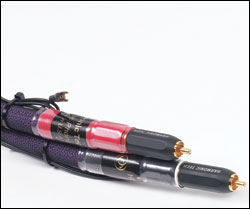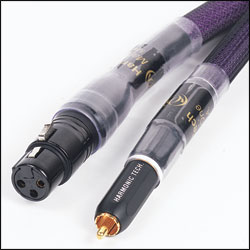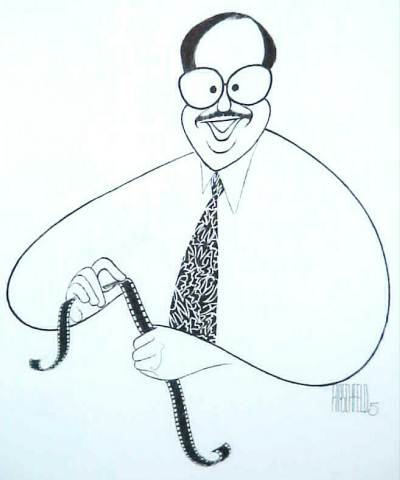
harmonic technology
Magic Phono cable
as reviewed by Robert H. Levi

|
With the best midband definition and more than competitive bass and high-band sound, the Harmonic Technology Magic Phono interconnects are about as good a tonearm connection that you can get today. Joining my favorite Kimber TAK Phono Ag and Dual-Connect 100 Gold, the Magic is a top contender for the best in phono connectivity.
At $900 for a one-meter pair, the Magic Phonos are priced between the Kimbers and the Dual-Connects. The Kimbers are solid silver, the Dual-Connects solid gold, and the Magics about 70 percent silver and 30 percent copper, with a patented molecular structure. The Magics are much bigger and heavier than the others. They should be used where space is not at a premium, and your turntable is not easily thrown out of balance. I needed to make a small balance change on my Townshend Seismic Sink with the Magics, but encountered no significant problems. The connectors are serious, screw-down RCAs, and they lock tightly. Each leg of the cable has its own ground connector. The cables were silent and hum-free when I used them with my .4mv-output ZYX cartridge.
On a scale of 100, I'd rate the three tonearm cables as follows:
| High | Mids | Bass | Detail | Grain | Quiet | Depth | |
| Magic | 92 | 99 | 94 | 96 | 92 | 96 | 99 |
| Dual-Connect | 97 | 95 | 90 | 93 | 98 | 95 | 95 |
| Kimber | 95 | 90 | 90 | 90 | 94 | 92 | 90 |
I wouldn't ignore any of these choices. All three push the state-of-the-art, but in some important parameters, the Magic is decidedly better than the others. The Magics are magic in the mids, with the best midband definition yet. They are more alive, more you-are-there, more textural than the others, plus they are more dynamic, with more traction. The ZYX has more of its terrific energy than ever before, and it is a joy to hear.
The bass is almost as good as the mids. With more dynamic power and definition than the other cables, the Magic bass really swings. It almost sounds digital, but with more analog textural cues. The silver/copper combination seems to suit phono better than the other metals. It gives the impression of better tracking by resolving the lower band more clearly. The Magics are also more cohesive. Imaging is more solid and defined, and spatial cues are better. They also seem to reduce surface noise a bit. Horns, cymbals, piano, and voices are all superb, with tons of texture, definition, and power. The backgrounds are blacker, and this very much enhances the musical experience.

Quibbles? While excellent, the highs are very slightly reticent compared to the mids. I also hear a touch more grain than I do with the other cables. These are very minor quibbles. It's just that the mids, bass, depth, and definition are so stellar. It could also be that the Magics' incredible traction and power bring out deficiencies in the ZYX that I never heard before. Who knows? I played record after record. While the Magics kept me more involved and entertained than before, going back to the others was still rewarding, and yielded other benefits. The delicacy of the Dual-Connects and the silky smoothness of the Kimbers are lovely, although neither sound as lifelike as the Magics.
With lots of dynamic power and class, the Magic Phono interconnects by Harmonic Technology are winners and then some. Every LP will sound more alive than you have ever heard it, with top-notch midband detail and depth. I love their realistic sound and the way they invite 110 percent from your cartridge. They are also the quietest phono cables yet. Until (or if) Harmonic Technology comes up with a Cyberlight solution to phono, their Magic Phono cables are my choice for the best tonearm cables around. Robert H. Levi
Reference recordings used in evaluating the Magic Phono interconnects included:
-
Percy Grainger, Country Gardens (Mercury SR 90219)
-
Duke Ellington, Blues in Orbit (Classic Records CS 8241)
-
Harry James, The King James Version (Sheffield Lab-3)
-
Linda Rondstadt, What's New (Elektra 60260)
-
Nikolai Rimsky-Korsakov, Scheherazade, Reiner (Classic Records, LSC 2446)
-
Getz/Gilberto (Mobile Fidelity, MFSL 1-208)
-
Edward Elgar, Enigma Variations, Barbirolli (Mercury SR 90215)
Magic Phono
Retail: $900
Harmonic Technology
web address: www.harmonictech.com
